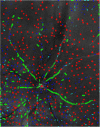A semi-automated technique for labeling and counting of apoptosing retinal cells
- PMID: 24902592
- PMCID: PMC4063694
- DOI: 10.1186/1471-2105-15-169
A semi-automated technique for labeling and counting of apoptosing retinal cells
Abstract
Background: Retinal ganglion cell (RGC) loss is one of the earliest and most important cellular changes in glaucoma. The DARC (Detection of Apoptosing Retinal Cells) technology enables in vivo real-time non-invasive imaging of single apoptosing retinal cells in animal models of glaucoma and Alzheimer's disease. To date, apoptosing RGCs imaged using DARC have been counted manually. This is time-consuming, labour-intensive, vulnerable to bias, and has considerable inter- and intra-operator variability.
Results: A semi-automated algorithm was developed which enabled automated identification of apoptosing RGCs labeled with fluorescent Annexin-5 on DARC images. Automated analysis included a pre-processing stage involving local-luminance and local-contrast "gain control", a "blob analysis" step to differentiate between cells, vessels and noise, and a method to exclude non-cell structures using specific combined 'size' and 'aspect' ratio criteria. Apoptosing retinal cells were counted by 3 masked operators, generating 'Gold-standard' mean manual cell counts, and were also counted using the newly developed automated algorithm. Comparison between automated cell counts and the mean manual cell counts on 66 DARC images showed significant correlation between the two methods (Pearson's correlation coefficient 0.978 (p < 0.001), R Squared = 0.956. The Intraclass correlation coefficient was 0.986 (95% CI 0.977-0.991, p < 0.001), and Cronbach's alpha measure of consistency = 0.986, confirming excellent correlation and consistency. No significant difference (p = 0.922, 95% CI: -5.53 to 6.10) was detected between the cell counts of the two methods.
Conclusions: The novel automated algorithm enabled accurate quantification of apoptosing RGCs that is highly comparable to manual counting, and appears to minimise operator-bias, whilst being both fast and reproducible. This may prove to be a valuable method of quantifying apoptosing retinal cells, with particular relevance to translation in the clinic, where a Phase I clinical trial of DARC in glaucoma patients is due to start shortly.
Figures












References
-
- Quigley HA, Nickells RW, Kerrigan LA, Pease ME, Thibault DJ, Zack DJ. Retinal ganglion cell death in experimental glaucoma and after axotomy occurs by apoptosis. Invest Ophthalmol Vis Sci. 1995;36(5):774–786. - PubMed
-
- Bizrah MG, Guo L, Cordeiro MF. Glaucoma and Alzheimer’s disease in the elderly. Aging Health. 2011;7(5):719–733. doi: 10.2217/ahe.11.51. - DOI
Publication types
MeSH terms
Grants and funding
LinkOut - more resources
Full Text Sources
Other Literature Sources
Molecular Biology Databases

